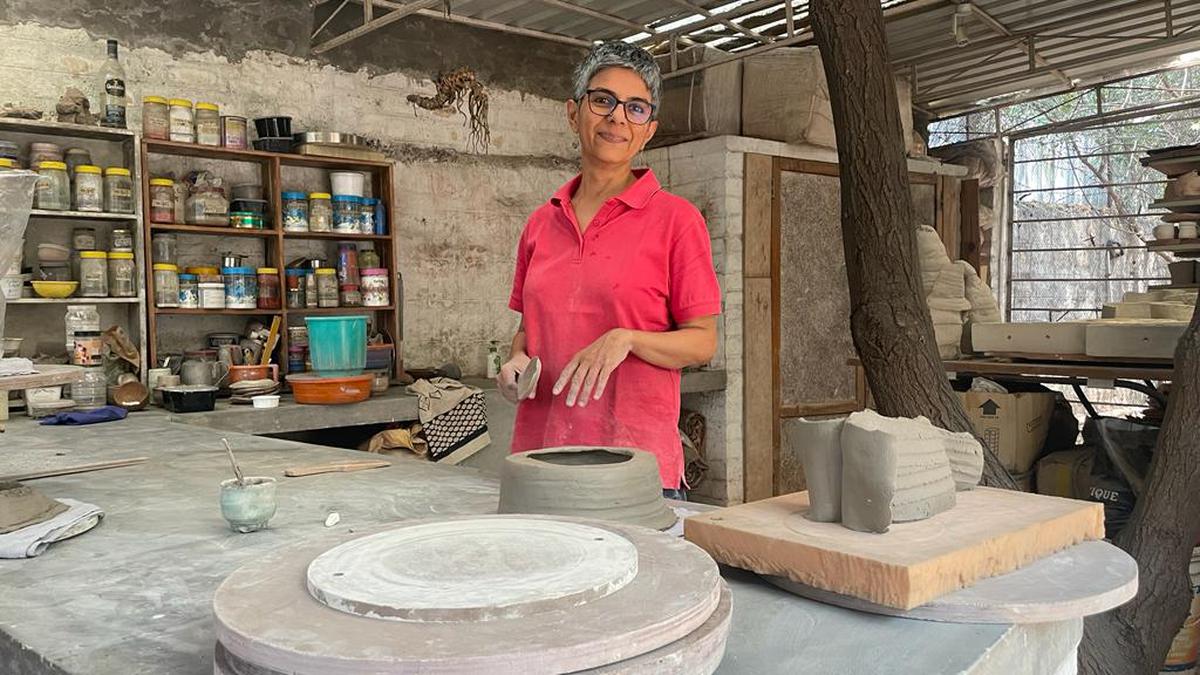
Ceramic artist Aarti Vir celebrates the Earth in her works
The Hindu
Ceramic artist Aarti Vir celebrates the Earth in her works while mourning for things lost
The colours of the soil come alive in artist Aarti Vir’s installation at Goethe Zentrum in Hyderabad. Twenty two pairs of feet made of coloured clay sit lightly on semicircular mud . Taking inspiration from the world around her, Aarti has curated and created the show, My Heart Dresses in Black and Dances - Mary Oliver, a collection of abstract watercolour paintings and handmade ceramics, to commemorate the World Earth Day on April 22.
In February, the ceramic artist was invited by Goethe Zentrum to showcase some of her works to mark Earth Day. “Since I work with clay, it was appropriate but in this short period, I couldn’t work more in ceramics.”
She did, however, manage to put up a few abstract watercolour paintings created during the pandemic along with a couple of her unseen ceramic works . “Earth Day is a celebration of the Earth but in some ways, it is also a mourning for things that we have lost; There are so many species that have gone extinct, so many forests being completely decimated. We are losing things which we may never get back,” says Aarti, adding that the title ‘My Heart Dresses in Black and Dances’ is a line from Mary Oliver’s poetry that suited the show and evoked many emotions. “Mary Oliver addresses a lot of these things in beautiful ways.”
Aarti cites an example of how the pandemic was terrible for many people across continents but a blessing in disguise for some families. “Earlier, my husband used to travel a lot and after many years, due to the pandemic, he was spending so much time at home. It was nice for all of us to spend so much time together as a family. “
Aarti had studied painting but once she began working with ceramics, painting took a backseat. With no access to the studio after she gave up that space in 2019, she rediscovered paints during the pandemic.
The coloured clay ceramic installation, an exploration journey was during a transition. When she had to give up her studio of 20 years in 2019, she sketched her own feet and wondered how the ground would change. “It was also born from an idea of the fact that we are all different but stand on the same Earth. We do share the ground but the inequality is there for everyone to see.”
The 22 pairs have been hand built, painted with coloured slips (liquid clay with added colourants) and then fired. The tiles installation has been created from sketches. Standing on the wet clay, the artist made a foot impression. “Whatever you do leaves an impression.”

When fed into Latin, pusilla comes out denoting “very small”. The Baillon’s crake can be missed in the field, when it is at a distance, as the magnification of the human eye is woefully short of what it takes to pick up this tiny creature. The other factor is the Baillon’s crake’s predisposition to present less of itself: it moves about furtively and slides into the reeds at the slightest suspicion of being noticed. But if you are keen on observing the Baillon’s crake or the ruddy breasted crake in the field, in Chennai, this would be the best time to put in efforts towards that end. These birds live amidst reeds, the bulrushes, which are likely to lose their density now as they would shrivel and go brown, leaving wide gaps, thereby reducing the cover for these tiddly birds to stay inscrutable.












